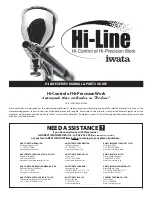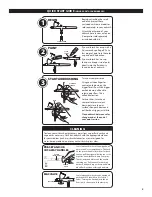
4
GENERAL OPERATION
Wide-Lines and Blending
1. Depress the main lever (#7).
2. Position the airbrush from 1/2 to 6 inches away from the surface.
3. Pull the main lever back much further to release more paint to cover
the bigger area.
• A longer distance to the paint surface produces wider lines.
• A shorter distance to the paint surface produces narrower lines.
• Increased air pressure increases spray width.
• Decreased air pressure decreases spray width.
• The maximum usable line width is approximately 2 inches.
Pre-Set Handle (#17)
A threaded adjusting screw mounted behind the handle limits the distance the main
lever can be pulled back. This provides accurate paint volume control and is especially
useful for repetitive, precision work.
Cutaway Handle
The cutaway handle allows quick paint clog removal without removing the handle
or needle.
1. Grip the exposed needle chuckling nut (#16) with your fingers.
2. Pull it back while simultaneously depressing the main lever (#7).
3. Repeat this process several times until the airbrush is clog free and
spraying normally.
• The increased paint flow past needle and nozzle tip removes many clogs.
• Don’t let the needle “snap” back into place. This could damage the nozzle.
Micro Air Control (MAC) Valve
The MAC Valve (#29) enables infinite airflow control at the airbrush’s head providing
control between stipple, fine detail, and background spray effects.
• Spray coarse stippling effects and increase to full atomization in a quick turn.
• Fine tuned airflow.
• Maximized paint atomization control.
• Open the valve fully during cleaning. The higher pressure pulls more paint
through the airbrush.
Stippling
Iwata airbrushes are designed to produce a wide range of stippling textures.
1. Unscrew the needle cap (#1).
2. Unscrew the nozzle cap (#2).
3. Adjust the air pressure between 8 and 60 psi.
• Low air pressure creates coarse stipples.
• High air pressure provides fine stipple effects.
• Paint viscosity also effects stippling texture.
Air Pressure
Working pressures generally vary between 8 and 60 psi, depending on the type of
surface, the desired spray texture, and the paint’s viscosity.
Start spraying with 15 psi. If the spray is too grainy adjust the pressure up until the
desired spray consistency is reached.
• Different colors will behave differently.
• Different paint lines will behave differently.
• Spray thick paint with greater pressure.
• Spray thin paint with less pressure.
• Spray large paint amounts with greater pressure.
• Spray small paint amounts with less pressure.
WARNING: Do not exceed 98psi.
Paint Preparation
For non-specific airbrush paints, proper preparation, including filtering the paint
through a nylon mesh, is critical for best performance. Thin paint with its proper
solvent, and make repeated passes across the work to build up the color. This
improves your work’s quality and decreases your airbrush’s cleaning time.
• Airbrushes spray very thin paint easiest.
• Thin paint with its proper solvent.
• Filter paint through paint filters or mesh.
Safety Tips
• Always spray in well ventilated areas.
• Do not spray solvent based (flammable) paints around open flames.
• Use the appropriate respirator to safely filter out paint vapors particular to your
specific paint type.
• Wear eye protection to prevent paint contact with eyes.
• Never exceed the airbrush’s pressure limit (98 psi).
GETTING STARTED
Compressor
Though Hi-Line Series airbrushes can function on minimal amounts of air, their full
versatility requires an adjustable or regulated air source with an air storage tank.
Other compressor considerations include the length of use while spraying
and the environment, or amount of space, you spray in.
These Iwata Studio Series models come equipped with an air regulator for precise
air adjustment:
• Smart Jet Pro: Good for small studios and normal use.
• Power Jet Lite: Good for normal studios and extended use.
• Power Jet: Great for normal studios and great for extended use.
• Power Jet Pro: Great for normal studios and great for extended use.
(Two regulators allow two airbrushes on same unit.)
Assembly
1. Screw the airhose onto the compressor.
2. Screw the airhose onto the airbrush.
3. If using a Smart Jet Pro, Power Jet, Power Jet Lite, or Power Jet Pro compressor,
adjust the pressure to between 10 and 15 psi.
4. Check for any air leaks in the compressor or airhoses.
5. Place a few drops of cleaning solution or water into the airbrush’s bowl.
6. Point the airbrush away from you.
7. Press down on the main lever (#7) to start airflow through the airbrush.
8. Pull the main lever back opening the airbrush’s nozzle.
9. Spray water through the airbrush to see how it sprays.



























